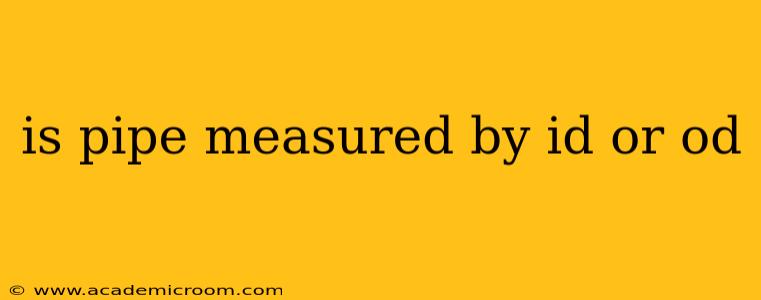Is Pipe Measured by ID or OD? Understanding Pipe Dimensions
The question of whether pipe is measured by its inner diameter (ID) or outer diameter (OD) is a common one, and the answer isn't always straightforward. It depends on the type of pipe and the context. Let's break it down.
Generally speaking, most metal pipes (steel, stainless steel, etc.) are sized by their Nominal Pipe Size (NPS) which is based on the inside diameter (ID), although it doesn't directly correspond to it. This is a historical convention. The NPS is a convenient reference point, but the actual ID and OD will vary depending on the pipe's schedule (wall thickness). A thicker schedule means a smaller ID.
Plastic pipes (PVC, CPVC, etc.) are typically sized by their outside diameter (OD). This is because the manufacturing process for plastic pipes usually controls the outer dimensions more precisely than the inner dimensions. The wall thickness is then specified separately.
What is Nominal Pipe Size (NPS)?
The NPS is not a direct measurement of the ID or OD, but a reference number used for standardization. Different schedules of the same NPS will have varying ID and OD measurements. Understanding this is crucial to avoid confusion.
What about other types of pipe?
Other types of piping, such as tubing, might use different sizing conventions, so it's always essential to check the manufacturer's specifications.
How do I find the ID and OD of a specific pipe?
To determine the precise ID and OD of a specific pipe, always refer to the manufacturer's specifications or datasheets. These documents provide detailed dimensions for each pipe size and schedule. You can often find this information online or on the pipe itself if it's clearly labeled.
Why is there a difference in how metal and plastic pipes are measured?
The difference stems from the manufacturing processes and materials. Metal pipes, traditionally forged or welded, have variations in wall thickness that make the OD less reliable as a standard sizing method. Plastic pipes, on the other hand, are often extruded, creating consistent outer diameters.
What is pipe schedule?
Pipe schedule refers to the wall thickness of the pipe. A higher schedule number indicates a thicker wall, meaning a smaller internal diameter (ID) for a given NPS. This is important because different applications require different levels of pressure and structural integrity.
Does the ID or OD affect flow rate?
The inner diameter (ID) of the pipe directly impacts the flow rate of fluids. A larger ID allows for greater flow. While the OD is important for structural strength and connection fittings, it doesn't directly affect the flow rate within the pipe.
Where can I find pipe dimension charts?
Many manufacturers and distributors publish comprehensive pipe dimension charts online, which often include the NPS, OD, ID, and wall thickness for various pipe sizes and materials. Searching for "[material type] pipe dimensions chart" (e.g., "steel pipe dimensions chart") on the internet will likely yield several helpful results.
By understanding the nuances of pipe sizing, you can select the right pipe for your application and avoid common mistakes associated with dimension confusion. Always refer to official specifications to ensure accuracy.
